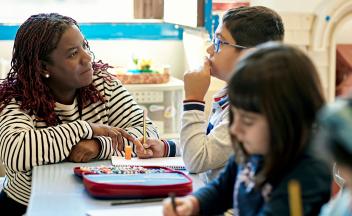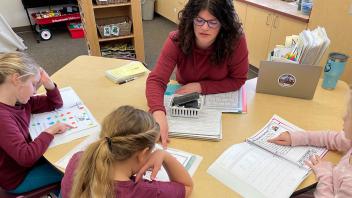Introduction to the science of reading
How do we know what is true about how and why children learn to read? The science of reading means using evidence gleaned from rigorous research to guide effective classroom practices (Reyna, 2004). The research evidence to explain how children learn to read, write, and spell has been developed over the last 50+ years. The studies on learning to read have come from diverse sources including education, linguistics, psychology, and neuroscience.
The science on how our brains learn to read is well-established (Seidenberg, 2017; D’Mello & Gabrieli, 2018), but don’t confuse basic research on how and why reading develops with research on successful instructional practices (Shanahan, 2020). Educators and policymakers must look for the evidence-base for specific instructional programs and practices to see what works and if the findings can be applied to their own schools, classrooms, and students.
But how do we know if a study that we’ve found can be trusted or is high quality? Here are some tips when thinking about reading research. First, did the study undergo a peer review process? This means an objective group of content experts reviewed and approved the work for publication. This is a minimum standard for trustworthiness, since some publications have more stringent criteria than others.
Understanding research design
Quantitative and qualitative studies
Next, it helps to understand a little bit about research design. A researcher uses their knowledge and experience to come up with a question about a topic that needs more detail or explanation. They search the existing body of knowledge to find out what others have learned on the topic. Often research questions attempt to solve a problem of practice in a school. There are two main types of approaches used to answer research questions:
- Quantitative studies use statistical analysis to observe, count, and compare large groups of individuals and events. Quantitative analysis can answer questions, such as, “what causes X?” or “Is Y better than Z at teaching kids how to read?” Quantitative analysis can help us determine the causes and effects of instruction on learning to read. In a well-designed study, it allows the researcher to consider and rule out alternative explanations for the studied phenomena.
- Qualitative studies answer descriptive questions about “how” or “why” something happened. Qualitative research relies mostly on observation and description of what’s happening in a specific setting. Qualitative analysis gives the researcher details about what happened by sifting various types of evidence: e.g., observations, surveys, interviews, and analysis of documents (e.g., lesson plans or curriculum guides). Through careful analysis, a researcher may find patterns to better understand a phenomenon or an outcome. Qualitative studies answer questions like, “How was instructional practice X used in a classroom? or “Why does practice A operate/look differently from practice B under these conditions?”
It’s important to understand that qualitative studies cannot tell us directly what caused an outcome, so you cannot generalize the results to other schools and classrooms. A potential strength of a qualitative study is that it can help us better understand the conditions under which an observed phenomenon works (or doesn’t).
Mixed methods
Researchers can mix both quantitative and qualitative approaches together. A mixed methods design can answer questions that neither approach could do alone and gives a wider perspective on a topic. These studies can be more complex to design and interpret, since it requires careful planning to integrate quantitative and qualitative data in a single study.
Is a single well-designed study enough to be considered “evidence”?
No, a single study, however well designed, may point us toward a tentative conclusion, but we need many studies, hopefully across similar topics and different disciplines, to provide converging sources of evidence. It’s the weight of the overall evidence that allows the public to be confident that a finding can be generalized across schools, classrooms, and students.
Where to look for guidance
I’m not a reading expert. How do I know if a program or classroom practice is effective?
Although social media sites such as Teachers Pay Teacher, classroom blogs, and Pinterest may pop up on a browser search for a program or practice, these sources are not peer reviewed and can often promote popular but unproven — or even unsound — educational practices.
But here’s the good news. You don’t need to be a content expert or researcher to discover which instructional practices or programs represent the most current science. The federally funded What Works Clearinghouse (WWC) offers trusted reports and practice guides on the research behind reading instruction. WWC is a free resource for educators and policymakers. The Best Evidence Encyclopedia (BEE) is a free resource created by the Johns Hopkins University School of Education’s Center for Research and Reform in Education. It gives educators and researchers information about the strength of the evidence supporting a variety of programs available for students in grades K-12. The BEE mostly consists of systematic meta-analyses of research on effective programs.
There are other reliable sources to help guide you, such as Reading Rockets and our sister sites, Colorín Colorado and AdLit . The research on reading is constantly evolving and changing, and our sites aim to provide users with what’s current and has the weight of evidence to support it.
What does the science of reading look like in my classroom?
Although children learn to listen and speak without formal instruction, learning to read is not natural. It must be taught. Teaching read is complex and requires extensive knowledge and training (Adams, 1990; Moats, 1995). In the primary grades, students benefit from carefully planned systematic and explicit instruction rather than incidental learning about print. It may mean abandoning popular practices that may be popular but do not have the weight of evidence to support their continued use, e.g., teaching cueing strategies to decode words or using leveled books in a lockstep fashion (Hanford, 2018 ).
Teachers who align their instruction with the science of reading should examine their practices to include the development of oral language skills, alphabet knowledge, phonemic awareness, phonics, reading fluency, vocabulary, and reading comprehension strategies (Foorman et al., 2016; NRP, 2000; NELP, 2008; Snow et al, 1998). A good starting place is for principals and teachers to evaluate the critical elements in their school’s core literacy program. Here are two helpful resources:
- The University of Oregon published a free Consumer’s Guide (2006) that allows you to evaluate the components of your core program.
- The Reading League offers a free tool to evaluate your school’s reading curriculum .
- The Reading League and the National Committee for Effective Literacy issued this joint statement (2023): Understanding the Difference: The Science of Reading and Implementation for English Learners/Emergent Bilinguals (ELs/EBs) .
What is the science of reading?
This video from the University of Florida Literacy Institute (UFLI) provides a brief overview of the science of reading and the different bodies of research that contribute to it.
Learn more about the science of reading
Shanahan on Literacy
What Is the Science of Reading?
Shanahan on Literacy
Q&A About the Science of Reading
Research Report
What Constitutes a Science of Reading?
Guides and Toolkits
Science of Reading: Defining Guide
Curriculum and Instruction






